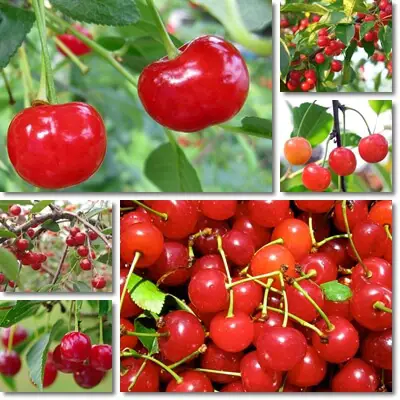Montmorency cherries are one of two major groups of tart cherries called Amarelle. While lower in antioxidant anthocyanins compared to Morello and black cherries, Montmorency are nonetheless a source of good nutrition and important health benefits.
Montmorency cherries, cherry juice and concentrate provide benefits for inflammatory conditions such as arthritis, gout and benefits for exercise-related muscle damage as well as promote muscle recovery after a workout.
The tart cherry variety is especially good for sleep, increasing sleep time and improving sleep quality.
What are Montmorency cherries?
Montmorency cherries are a type of sour or tart cherry. They are a variety of Amarelle cherry which is a lighter-colored sour cherry with bright red skin and little color to the pulp and juice (as opposed to Morello cherries which are darker-colored with dark red skin and red flesh and juice). Sour-tasting, flavorful and juicy, Montmorency cherries are a cultivar with great commercial value, the source of the popular Montmorency cherry juice and cherry concentrate.

What do Montmorency cherries look like?
Faithful to their Amarelle cherry heritage, Montmorency cherries have bright red colored skin, visibly lighter compared to that of other tart cherries. Montmorency cherries concentrate most of their pigmentation in the skin, while the flesh is cream-colored with maybe some red around the pit or near the skin. Because the pulp is almost colorless, Montmorency cherry juice is a paler red color compared to black cherry juice or cherry juice made from cherries of the Morelle cultivar.
Other than this, each cherry has a hard-shelled, light brown stone or pit in the middle with a milky white, bitter kernel inside. Montmorency cherries come in different sizes depending on the variety, but retain the plump, slightly heart-shaped and grooved appearance typical of cherries.
What do Montmorency cherries taste like?
Montmorency tart cherries have a smooth, thin, light red skin and juicy, somewhat colorless pulp. The skin is tangy and sour, while the juicy pulp is soft and tart. If underripe, the cherries will taste particularly sour and their astringency will be more pronounced, often to the point you may find it difficult to eat more than a few raw.
Ripe and overripe Montmorency cherries also taste sour, but are also sweeter and more flavorful. This is owed to the ripening process which helps develop the natural sugars in the fruit as well as flavor compounds that counterbalance the sharpness for a more pleasant taste experience.

Can you eat Montmorency cherry pits?
What happens if you accidentally swallow a cherry pit?
If it’s one pit and you’ve already swallowed it, then nothing bad should happen. If it’s the seed inside the cherry pit and it’s just one, you should also be okay. But don’t go eating cherry pits or seeds, Montmorency or another kind, because they are not safe to eat. It’s actually dangerous to deliberately eat cherry pits and especially cherry seed kernels because they contain toxic compounds called cyanogenic glycosides which are broken down during digestion and release poisonous hydrogen cyanide. Toxicity is dose-dependent so the more you eat at once, the more likely and severe the side effects.[/natureword]
Montmorency cherries nutrition facts
The Montmorency sour cherry is about as nutritious as any other sour cherry, with a few exceptions. For instance, the paler red color of the cherry skin and lack of red pigmentation of the cherry flesh have been correlated with a lower content of pigmented anthocyanin antioxidants, lower than in Amarelle and black cherries.
Montmorency cherries are also a good source of melatonin, a neurohormone that holds benefits for sleep. How much melatonin in Montmorency cherries?
According to a study, Montmorency cherries have up to 6 times more melatonin than Balaton cherries. Find out more about the benefits of cherries for sleep.
Otherwise, Montmorency cherries are a good source of vitamin C with over 10% the daily recommended intake for the average adult per 100 g serving.
The variety is higher in pro-vitamin A than sweet cherries with an average content of 8% of the recommended daily intake, and a good source of potassium and magnesium at 3.5% and 3% of daily values.
Montmorency cherries are almost sodium-free and a modest, but varied source of B vitamins and minerals, including vitamins B1, B2, B3, B5, B6, B9, calcium, iron, manganese, phosphorus and zinc (under 5% of daily values). Low in calories, they have an energetic value of only 50 kilocalories/100 g, and only 8.5 grams of sugar.
What are the benefits of Montmorency cherries?
What are Montmorency cherries good for? See the benefits below:
- Benefits for sleep. Regular consumption of Montmorency cherries and cherry juice can help you sleep better and longer.
- Anti-inflammatory food. Montmorency tart cherries and cherry juice can help with arthritis joint pain and swelling by reducing levels of several inflammation markers including COX-1 and COX-2 and C-reactive protein.
- Benefits for gout. Morello cherries and cherry juice are low in purines, reduce uric acid levels in the blood and inflammation markers contributing to gout flareups.
- Benefits for muscle recovery. Montmorency cherries and cherry juice help with muscle recovery post exercise and are good to eat and drink both before and after a workout, helping reduce exercise-induced muscle soreness, pain and loss of strength. Find out more about the benefits of cherries for muscle recovery.
- Mild laxative properties, good for relieving constipation naturally.
- Good for high blood pressure. Potassium and magnesium in Montmorency cherries provide anti-hypertensive benefits.
- Benefits for teeth and gums. Montmorency cherries help keep teeth and gums healthy thanks to a good vitamin C content.
- Good for diabetes. Montmorency cherries have a low glycemic index score of only 20, 20-something and don’t raise blood sugar levels too much too fast.
- Benefits for weight loss. Low in calories and fat and a moderate source of carbs, Montmorency cherries help you lose weight in a healthy manner.
- Benefits for vision. High in pro-vitamin A antioxidants, the cherry variety supports visual acuity, color vision and night vision.
- Antiaging benefits. Antioxidants in Montmorency cherries and juice help prevent and repair cell damage caused by oxidative stress and delay premature aging, exerting antiaging benefits. One antioxidant in particular, vitamin C, supports collagen production for good skin elasticity, less wrinkles and a more youthful looking skin.
